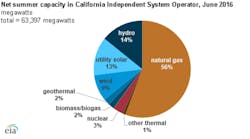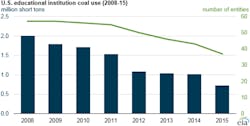Renewables provide more energy for California summer
Graphic courtesy of the EIA
Californians used less natural gas for their energy needs this summer, according to the U.S. Energy Information Administration (EIA). Meanwhile, renewables and imported electricity sources increased. Thermal generation, which is mostly from natural gas, was down 20 percent from last summer, while hydroelectricity, other renewables and electricity imports rose. Higher summer temperatures led to a two percent increase in electricity consumption in 2016.
Improved drought and water conditions fed the hydroelectric generation increase. New generating capacity contributed to change as well, with nonhydro renewables such as solar and wind representing 26 percent of capacity in June.
Graphic courtesy of the EIA
Pre-Labor Day gas prices lowest in a decade
The Aug. 29 regular gasoline price was $2.24 per gallon, the lowest price on the Monday before Labor Day since 2004, reported the EIA. The number was also 24 cents per gallon lower than the same time in 2015. The main drivers of the drop are lower crude oil prices caused by high global crude oil and petroleum product inventories and more U.S. drilling activity.
Higher crude oil prices and strong demand in the summer season led to a 51-cent increase in gasoline since February, when the country saw a price low point of $1.72 per gallon.
The West Coast has the highest regional prices of $2.59 per gallon, while the Gulf Coast’s $2.01-per-gallon price was the lowest in the U.S.
Graphic courtesy of the EIA
U.S. educational institution coal consumption declines 64 percent
Colleges and universities in the U.S. are using 64 percent less coal than they did in 2008, the EIA said. These institutions used 2 million short tons of coal in 2008 and 700, short tons in 2015. Only 57 institutions used coal in 2008, 20 of which no longer use it. Many of them participate in the American College and University Presidents Climate Commitment, which aims to reduce greenhouse gas emissions.
Indiana institutions have decreased coal consumption by 81 percent by replacing coal with natural gas and geothermal heat. Michigan schools reduced coal use by more than 80 percent with the adoption of natural gas, and three Tennessee institutions saw a 94 percent drop after converting cogeneration plants to burn only natural gas.





